Unpaid Invoice: 10 Simple Strategies for Collecting
In this blog we lay out some strategies when it comes to handling unpaid invoices.

94% of bookkeepers in the United States say they need to “chase down” clients to collect late payments. This is an unfortunate, and often stressful, part of running a business. Especially one in healthcare. Unpaid invoices, if left unaddressed, can result in a large sum of missing revenue. So, there’s no other choice in the matter but to follow up on them.
It is important to differentiate between something that is “common” and something that is “unavoidable”. Sure, late payments might be a common problem within your business, but that doesn’t mean they are entirely unavoidable. In fact, there are a few things you can incorporate into your daily tasks that can reduce your amount of outstanding payments.
In today’s blog, we will take a look at a few key factors when it comes to handling unpaid invoices.
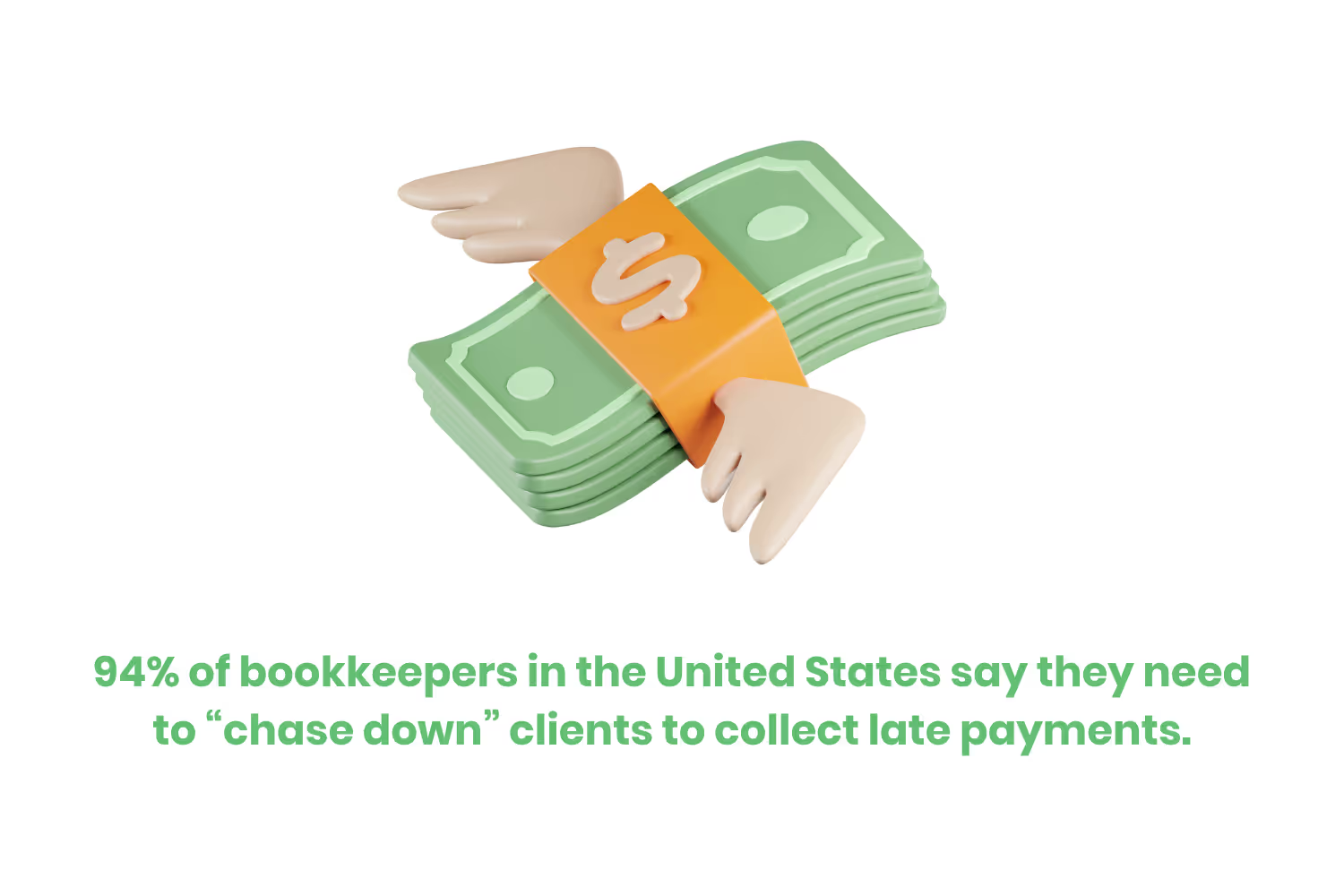
These details include:
- Discovering what causes them.
- How to prevent them.
- How to respond to an unpaid invoice.
So get comfy, grab a snack or some tea, and let’s lay out some strategies when it comes to handling unpaid invoices.
How Unpaid Invoices Affect Your Business
Did you know that a 2022 study found that 49% of business invoices in the United States become overdue? Almost half! That is a huge chunk of incoming revenue going right out the door, if not followed up on properly. So what exactly are unpaid invoices? These are bills that businesses issue to customers after delivering a service or product, however they remain unpaid. Pretty straightforward! The more unpaid invoices your company has floating around out in the ether, the less revenue your company collects. Therefore, less funding for your business.
These invoices can otherwise go by the name “accounts receivable”. Meaning, this is your company’s expected cash inflow. Your business holds entitlement to this revenue. Cash flow is your business’s lifeblood which covers things such as rent, salaries, and more. If there is a delay in cash flow, you can expect cash flow gaps that challenge your business’s ability to maintain operations and financial obligations.

Here are a few more instances in which unpaid invoices can negatively affect your business:
- Resource Allocation- If you have such an abundance of unpaid invoices that you must divert personnel to follow up with clients, you are inherently taking attention away from other important tasks. This can easily put a wrench in your overall business efficiency.
- Credit- If you are a business that relies on a line of credit, or even loans, high levels of unpaid invoices can negatively affect your credit rating. You are making it more difficult for you to secure the necessary financing.
- Investment and Growth- Any sort of financial strain comes with the risk of limitation to a business’s growth. Abilities to invest in new opportunities, hire additional staff, and expand operations, must then take a back seat.
- Budgeting- Being able to accurately forecast your finances is critical while running a business. Having an outstanding amount of unpaid invoices can complicate your budgeting efforts, making it difficult to allocate resources when thinking about future projects.
What Causes Unpaid Invoices?
At the end of the day, communication (or lack thereof) is the basis of unpaid invoices. After all, an invoice (at its most basic level) is about communication.
It’s a way for a business to signal to their customer that they offered them a service or product, and they now owe a balance. So when an invoice is not paid on time, we can rightfully assume that there is an issue with the communication.
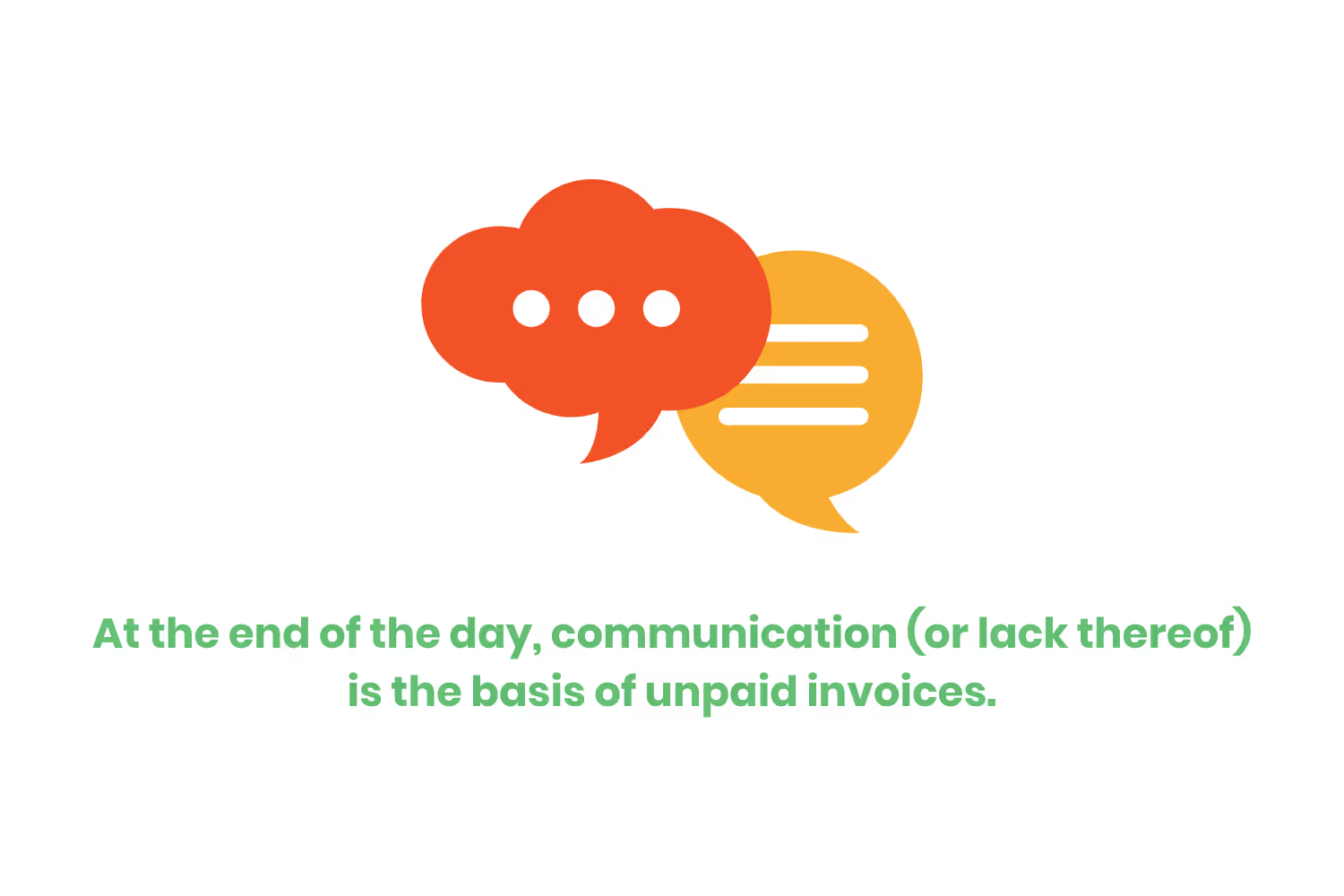
Here are some of the most common reasons for unpaid invoices:
- Customer cash flow issues: Your customers may need to delay payment due to their financial issues.
- Disputes: Disputes over invoices or services charged can easily result in delayed payments.
- Product or service issues: Similarly to the previous reason, if the product or service does not meet expectations a client may refuse payment.
- Manual processes: Human error when it comes to manually processing invoices can lead to delays in payment.
- Administrative errors: Errors when it comes to manually entering client information can lead to late or unpaid invoices.
- The customer forgets: The customer simply forgets.
- Technical glitches: System errors or other technical issues when gathering patient intake information may result in delayed payments, too.
10 Strategies for Preventing and Collecting Unpaid Invoices
Now that we know some causes of unpaid invoices and late charges, it’s time to get into how to both prevent and respond to them. I’m going to outline some key strategies that will help keep your cash flow…flowing.
More specifically, this list will help you learn what processes work best, how to reach out to clients, and what to do if someone refuses to pay. Let’s get started!
Strategy 1: Keep a Clear Line of Communication
Probably the most basic advice I would give is to make sure you have the right contact information for clear communication with your clients. This way, on the off chance your new patient doesn’t pay their bill, you will know how to contact them.
Reinforcing your billing policies and payment expectations with new patients so no misunderstandings going forward is also helpful.
Strategy 2: Collection Policy and Procedures
Let’s expand on the idea of collection policies and procedures. Making sure you define your payment terms upfront helps to reduce the chance of a misunderstanding between you and your patient.
Outlining information such as due dates, payment methods, and late fees is vital before performing services.
It is best practice to also have the patient acknowledge these terms in writing. When sending invoices, make sure your client can easily find their itemized services. As well as detailed instructions on how to pay.
Strategy 3: Consistent and Timely Follow-Up
With your established line of communication now in place, you can utilize the patient’s preferred form of contact to send friendly payment reminders! This can either be through email, text message, phone call, or even through the mail.
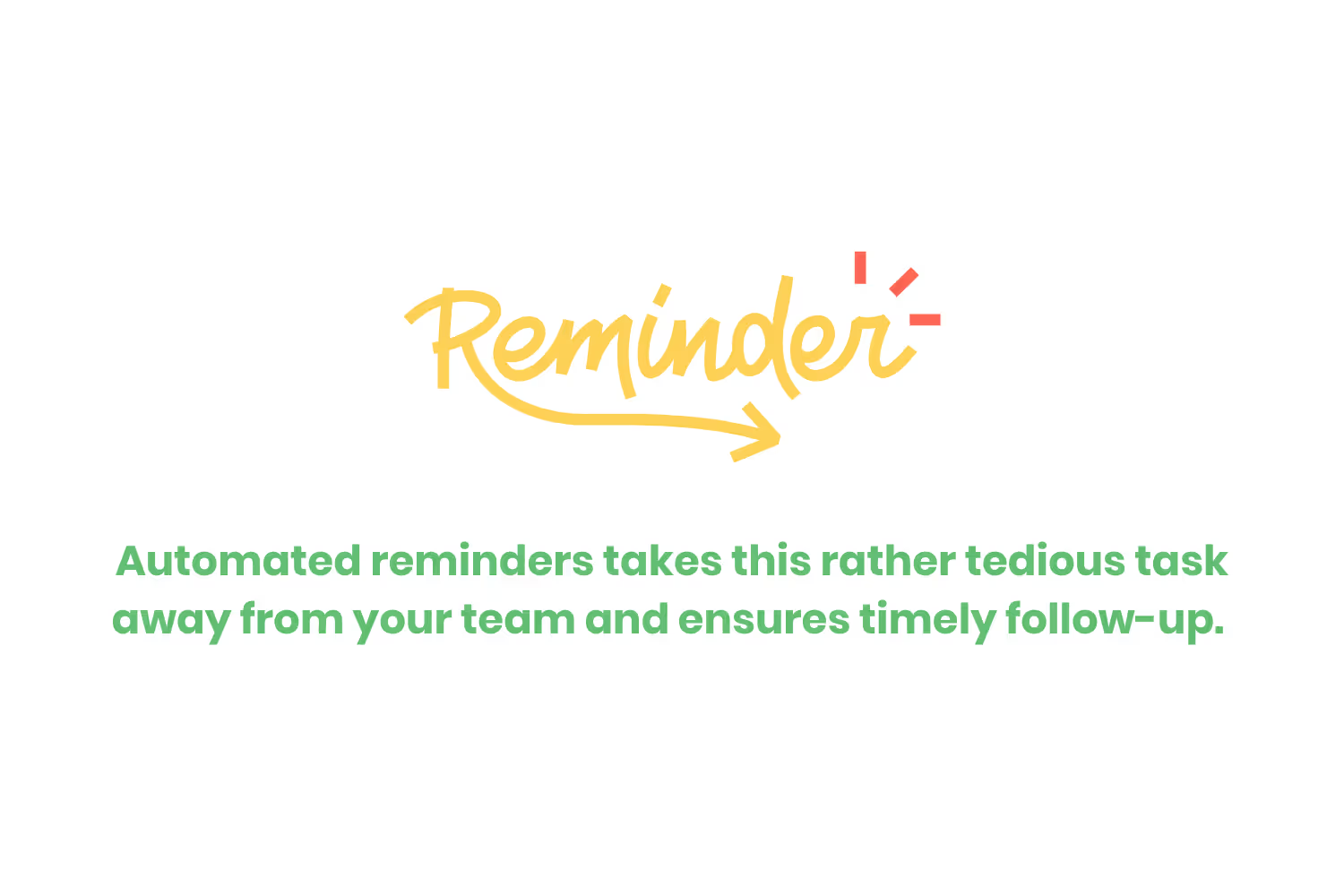
You can begin with a friendly reminder, but as time goes on feel free to send more formal reminders if payment is still outstanding.
If you use billing software, streamline your process with automated reminders! This takes this rather tedious task away from your team and ensures timely follow-up.
Strategy 4: Flexible Payment Options
Piggy-backing off of the last section, make sure to offer flexible means of communication. This includes access for patients to make payment plans, too.
Having the option to pay your bill in the way that is easiest to you takes the hassle out of an already… let’s say “not so fun” activity.
If your client is unable to make payments by the due date, consider offering payment plans. Not only does this guarantee some revenue paid, but builds trust with your clientele by showing that you empathize with their situation.
Strategy 5: Check Patient's Insurance Coverage
This strategy deals with healthcare only.
Make sure that before rendering any services, you check for your patient’s insurance coverage. This is a good way to prevent any misunderstandings about who is responsible for payment. By checking for insurance first, you ensure both you and the patient are on the same page.
Always make sure to confirm:
- Coverage.
- Copays.
- Deductibles.
- Out-of-pocket maximums.
Strategy 6: Utilize Technology
In healthcare, technology is vital when it comes to the billing and coding process. Using Electronic Health Records (EHR) systems helps to streamline your administrative tasks, tracking outstanding payments and managing accurate records.
You can also utilize patient portals to keep your clients in the loop when it comes to their overdue balances. They can also more easily make payments.
Strategy 7: Final Notice
If none of the above works, you might have to send a final notice or a formal letter of demand. These both instill a sense of urgency while also explaining how to mitigate the situation.
To add even more of a sense of urgency, you can send this notice via certified mail. This way, you can also receive notification when the recipient receives the letter.
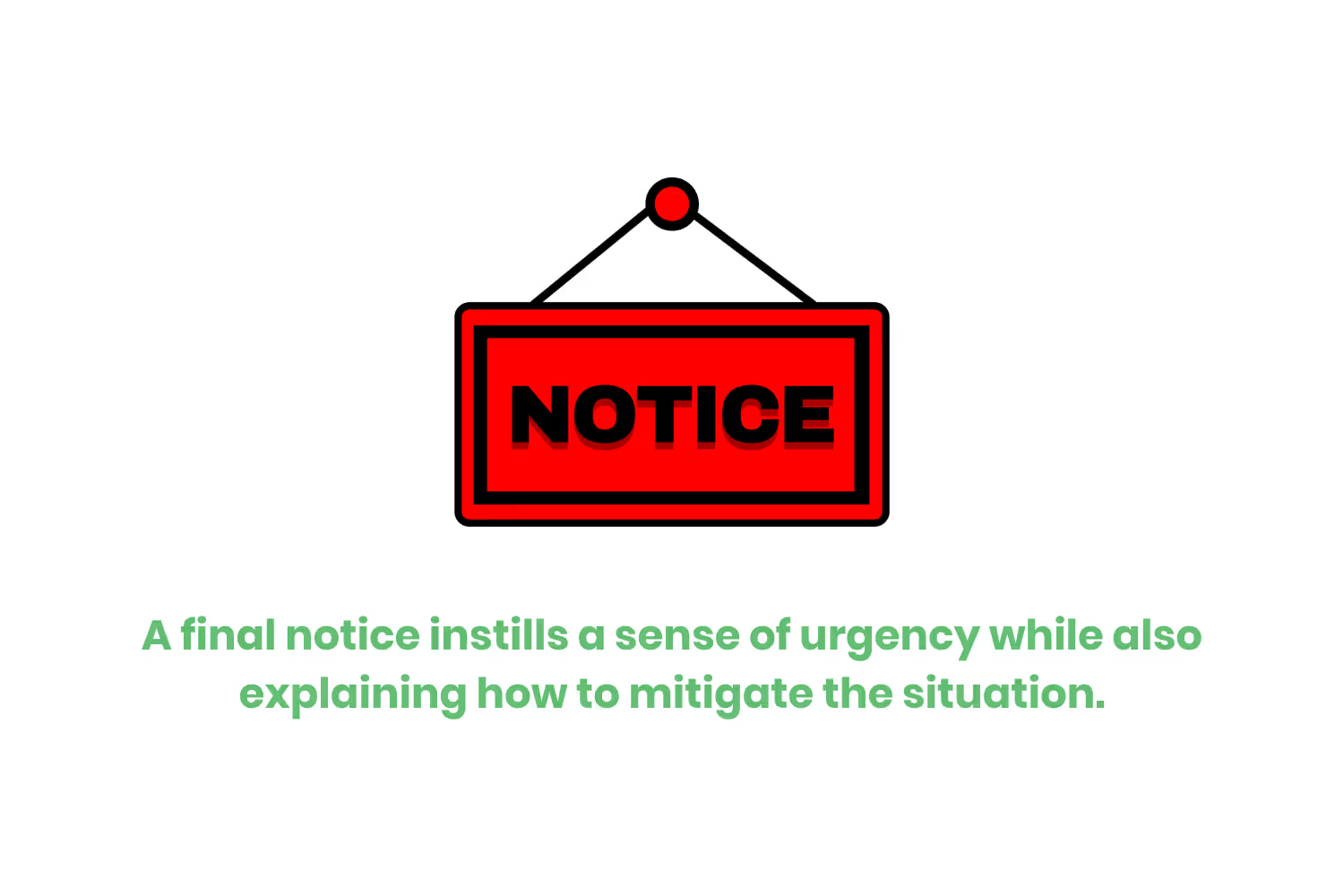
Strategy 8: Charge Interest/Late Fees
Charging interest or late fees is another way to instill some added urgency in making a payment on an overdue bill. This will also help incentivize paying the bill on time in the first place. If someone can avoid paying more for a service or product, why wouldn’t they? However, make sure you check legal guidelines before charging those interest rates. Different states have different limits when it comes to that sort of thing.
Be sure to have a discussion of late fees and interest charges with your patients beforehand. You want to avoid blindsiding them by not setting those expectations upfront. Excessive penalties can also leave your patients feeling punished, even if that isn’t your intent! Consider allowing them to take advantage of payment extensions to avoid unnecessary strain on your professional relationship.
Strategy 9: Filing a Complaint
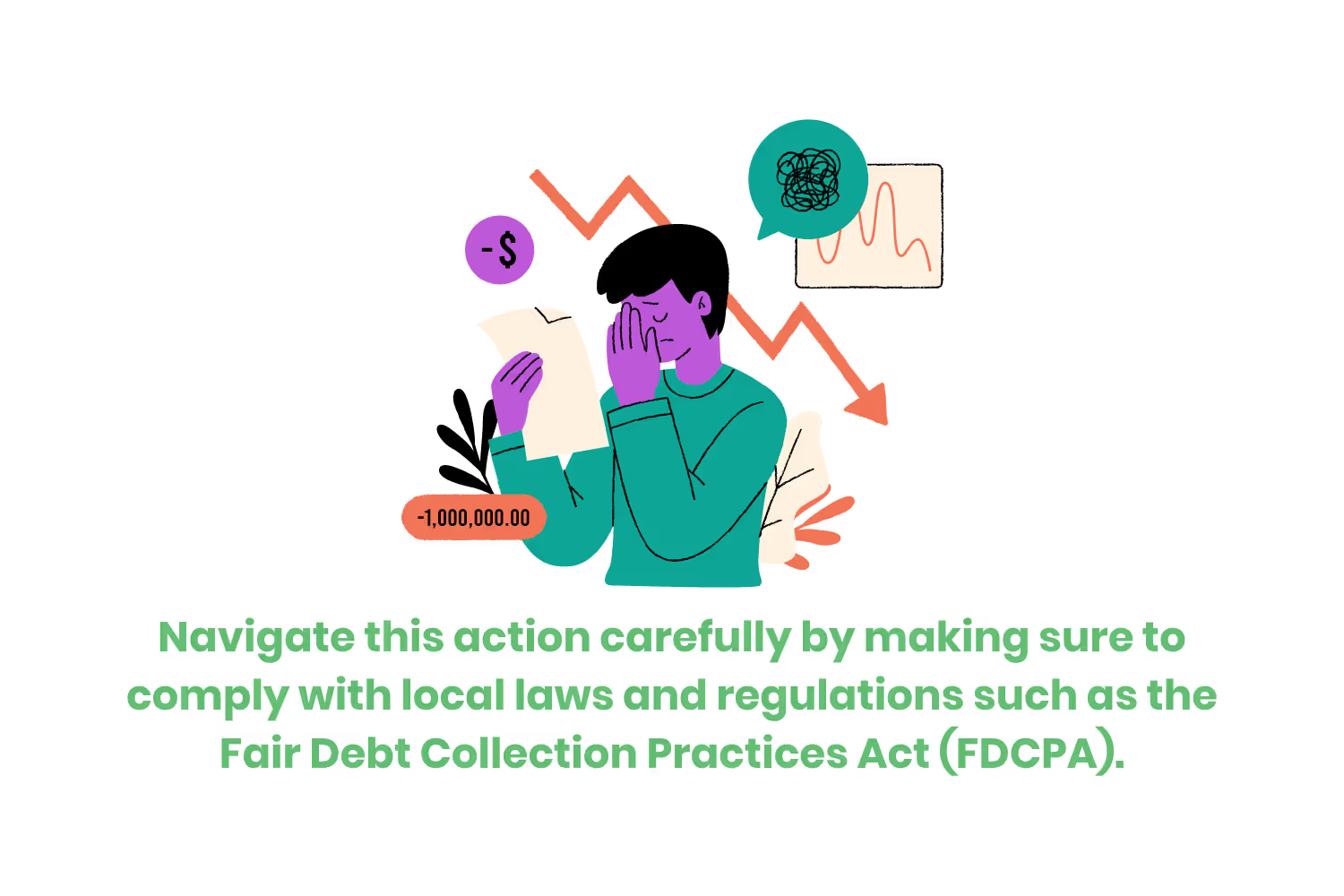
Taking legal action is usually the next step if you still are not receiving payment from a client. If you can’t get a hold of them, consider turning to an organization such as the Better Business Bureau or BBB for help.
Navigate this action carefully by making sure to comply with local laws and regulations such as the Fair Debt Collection Practices Act (FDCPA). This sets the standard for the treatment of debtors and also prohibits any abusive collection practices.
Strategy 10: Legal Considerations
Legal considerations to recover lost revenue may eventually involve courts and lawyers. This is usually a last resort, as going this route tends to take time and money. Although, if you are missing a large sum of money, it may be worth the effort.
You can also choose to take the client to small claims court. Or make a court claim for money. This way, you can settle the dispute without needing a lawyer. If all else fails, consider hiring a third-party collection agency.
Conclusion
While unpaid invoices are the reality of every healthcare organization, they don’t have to be the cornerstone. By implementing strong billing strategies such as clear communication and timely follow-ups, you can reduce the number of unpaid invoices.
Safeguarding your business from financial strain and uncertainty by defining your collection policies upfront. All while utilizing the best revenue cycle billing software to streamline your workflow. With the right practices, you can protect your financial health while still catering to your patients.
Emphasize your product's unique features or benefits to differentiate it from competitors
In nec dictum adipiscing pharetra enim etiam scelerisque dolor purus ipsum egestas cursus vulputate arcu egestas ut eu sed mollis consectetur mattis pharetra curabitur et maecenas in mattis fames consectetur ipsum quis risus mauris aliquam ornare nisl purus at ipsum nulla accumsan consectetur vestibulum suspendisse aliquam condimentum scelerisque lacinia pellentesque vestibulum condimentum turpis ligula pharetra dictum sapien facilisis sapien at sagittis et cursus congue.
- Pharetra curabitur et maecenas in mattis fames consectetur ipsum quis risus.
- Justo urna nisi auctor consequat consectetur dolor lectus blandit.
- Eget egestas volutpat lacinia vestibulum vitae mattis hendrerit.
- Ornare elit odio tellus orci bibendum dictum id sem congue enim amet diam.
Incorporate statistics or specific numbers to highlight the effectiveness or popularity of your offering
Convallis pellentesque ullamcorper sapien sed tristique fermentum proin amet quam tincidunt feugiat vitae neque quisque odio ut pellentesque ac mauris eget lectus. Pretium arcu turpis lacus sapien sit at eu sapien duis magna nunc nibh nam non ut nibh ultrices ultrices elementum egestas enim nisl sed cursus pellentesque sit dignissim enim euismod sit et convallis sed pelis viverra quam at nisl sit pharetra enim nisl nec vestibulum posuere in volutpat sed blandit neque risus.

Use time-sensitive language to encourage immediate action, such as "Limited Time Offer
Feugiat vitae neque quisque odio ut pellentesque ac mauris eget lectus. Pretium arcu turpis lacus sapien sit at eu sapien duis magna nunc nibh nam non ut nibh ultrices ultrices elementum egestas enim nisl sed cursus pellentesque sit dignissim enim euismod sit et convallis sed pelis viverra quam at nisl sit pharetra enim nisl nec vestibulum posuere in volutpat sed blandit neque risus.
- Pharetra curabitur et maecenas in mattis fames consectetur ipsum quis risus.
- Justo urna nisi auctor consequat consectetur dolor lectus blandit.
- Eget egestas volutpat lacinia vestibulum vitae mattis hendrerit.
- Ornare elit odio tellus orci bibendum dictum id sem congue enim amet diam.
Address customer pain points directly by showing how your product solves their problems
Feugiat vitae neque quisque odio ut pellentesque ac mauris eget lectus. Pretium arcu turpis lacus sapien sit at eu sapien duis magna nunc nibh nam non ut nibh ultrices ultrices elementum egestas enim nisl sed cursus pellentesque sit dignissim enim euismod sit et convallis sed pelis viverra quam at nisl sit pharetra enim nisl nec vestibulum posuere in volutpat sed blandit neque risus.
Vel etiam vel amet aenean eget in habitasse nunc duis tellus sem turpis risus aliquam ac volutpat tellus eu faucibus ullamcorper.
Tailor titles to your ideal customer segment using phrases like "Designed for Busy Professionals
Sed pretium id nibh id sit felis vitae volutpat volutpat adipiscing at sodales neque lectus mi phasellus commodo at elit suspendisse ornare faucibus lectus purus viverra in nec aliquet commodo et sed sed nisi tempor mi pellentesque arcu viverra pretium duis enim vulputate dignissim etiam ultrices vitae neque urna proin nibh diam turpis augue lacus.




